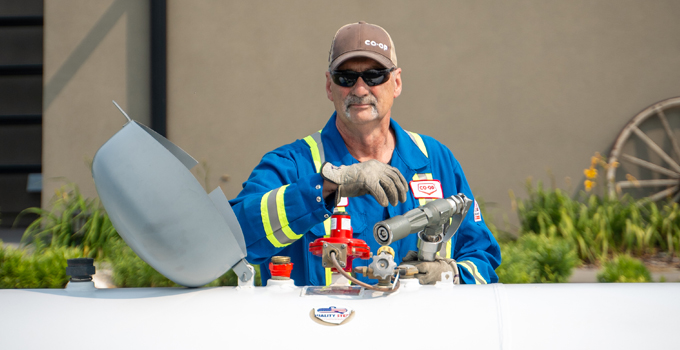Complying with federal regulations for propane tank pressure relief valve (PRV) replacement is a legal necessity that ensures a safe and uninterrupted supply of propane. Proactive planning and informed decision-making are key to a smoother transition to compliant tanks.

Legal background and provincial timelines
The Canadian Standards Association B51-14 code oversees boilers, pressure vessels and pressure piping. One of its mandates is a federal requirement that outlines maximum service intervals for PRVs in bulk propane tanks.
Upon the effective date of the PRV regulation, filling a tank with an outdated PRV becomes illegal. This necessitates proactive planning for PRV replacement to ensure continued legal use of propane tanks.
The B51-14 code execution varies by province. Please refer to the table below for specified provincial timelines for two tank size categories.


Compliance solutions
The Co-op Propane department is diligently working towards achieving compliance for all tanks owned by FCL. However, the customers who own their tanks will need to take the necessary measures to replace PRVs and ensure compliance. There are three options for addressing this.
Option 1: Propane supply and tank rental agreement
Customers can choose to sign a propane supply and tank rental agreement with Co-op. This requires covering the installation cost of a new or reconditioned propane tank. In return, the customer receives a credit equivalent to the value of their existing tank based on its capacity.
Option 2: Tank purchase and supply agreement
Another option is purchasing a new tank from Co-op and signing a propane supply agreement. Similar to the first option, the customers will also receive a credit for the value of their existing tank.
Option 3: PRV replacement
The third option involves replacing the PRV on the current tank. To explore this option, customers need to contact their local Co-op Propane branch to discuss their PRV replacement needs and available alternatives.
Installation scenarios and considerations
In scenarios where the existing propane tanks need replacement, the first step is extracting propane from them. Then the existing tank is taken out of service and replaced with a new or reconditioned tank.
Replacement tank installations must adhere to the current and applicable gas code to ensure compliance. After the installation, the new tank is filled and placed in service.
For customers choosing the third option, which involves replacing the PRV only, the process requires the tank to run completely empty. This involves accommodating a temporary disruption to the supply of propane during the replacement.
To discuss your options regarding PRV replacement, please contact your local Propane Region Branch office.

